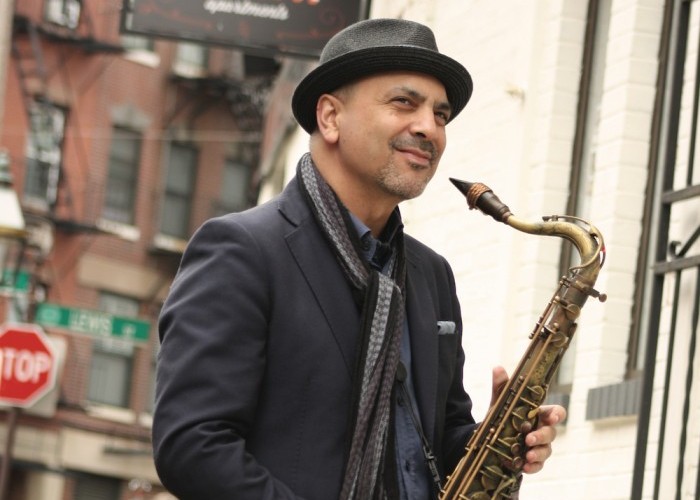Oct 28, 2025 10:47 AM
In Memoriam: Jack DeJohnette, 1942–2025
Jack DeJohnette, a bold and resourceful drummer and NEA Jazz Master who forged a unique vocabulary on the kit over his…

Marco Pignataro’s new album, Almas Antiguas, reflects elements of his professional and personal life.
(Photo: Lucy Pignataro)If jazz is a music of self-expression, it’s only natural that it should include autobiographical elements. Still, it’s not often that an artist presents a narrative as personal and sweeping as what saxophonist Marco Pignataro offers on his second album, Almas Antiguas (Zoho).
“This album documents everything involved with my personal life and my work life,” Pignataro said. There’s his youth in Bologna, Italy; his experiences as a professional musician, including work with his eventual mentor, bassist Eddie Gomez; and the academic career that took him from Puerto Rico, where he co-founded the Jazz and Caribbean Music Department at the Conservatory of Music, to Boston, where he’s currently managing director of the Berklee Global Jazz Institute.
“Even on my first CD, all the compositions were based on very personal, emotional impressions,” Pignataro said of his 2011 debut, Sofia’s Heart. “That’s the way I like to create music. Almas Antiguas represents a very particular frame of mind that I’ve been in for the last year, personally and emotionally.”
What Pignataro wanted to convey was a sense of narrative, so that listeners would hear a story unfold as the musicians performed. “I didn’t want it to be about my saxophone or my playing,” he explained. “I wanted it to be about the music, in which I happen to play saxophone.”
He also wanted the program to highlight strong melodies. “I come from a culture where melody is such an important part of expression,” he said. “There’s not an Italian musician I know who doesn’t have an attachment—or at least a certain sensitivity—to melody.”
As the pieces gestated, Pignataro developed a clear idea of how the music should sound, but less of a sense of who would actually create that sound. Gomez was a given. “Eddie and I have a 10-year relationship now,” he said. “I always start with Eddie being in the center.
“But then I started thinking about the other people. One day at the Berklee Global Jazz Institute, we had Alan Pasqua and Adam Cruz doing this master class. At one point, they played together, just piano and drums, and when I heard them, I heard exactly the sound that I was hearing in my mind. There’s something about the elegance, the sense of space and the sense of emotional output that they deliver when they play. Then I imagined Eddie in the center of it and thought, ‘This is just perfect.’”
Still, Pasqua, Gomez and Cruz never had played as an ensemble before. “When we all went into the studio, it was a big question mark,” Pignataro recalled. “We had barely rehearsed, and I really had no idea what would happen. And as we played the first song, it was as if this band always existed.” Tenor saxophonist George Garzone appears on three tracks of Almas Antiguas.
“Everybody was really clear on what I was trying to convey through the music,” Pignataro said. “[It] made sense to them, and the chemistry was really magical. I was proud of that. One of the things we’re trying to teach our students is how important it is to select musicians who will resonate with what you want to do.” DB

Jack DeJohnette boasted a musical resume that was as long as it was fearsome.
Oct 28, 2025 10:47 AM
Jack DeJohnette, a bold and resourceful drummer and NEA Jazz Master who forged a unique vocabulary on the kit over his…

D’Angelo achieved commercial and critical success experimenting with a fusion of jazz, funk, soul, R&B and hip-hop.
Oct 14, 2025 1:47 PM
D’Angelo, a Grammy-winning R&B and neo-soul singer, guitarist and pianist who exerted a profound influence on 21st…

Kandace Springs channeled Shirley Horn’s deliberate phrasing and sublime self-accompaniment during her set at this year’s Pittsburgh International Jazz Festival.
Sep 30, 2025 12:28 PM
Janis Burley, the Pittsburgh International Jazz Festival’s founder and artistic director, did not, as might be…

Jim McNeely’s singular body of work had a profound and lasting influence on many of today’s top jazz composers in the U.S. and in Europe.
Oct 7, 2025 3:40 PM
Pianist Jim McNeely, one of the most distinguished large ensemble jazz composers of his generation, died Sept. 26 at…

Drummond was cherished by generations of mainstream jazz listeners and bandleaders for his authoritative tonal presence, a defining quality of his style most apparent when he played his instrument unamplified.
Nov 4, 2025 11:39 AM
Ray Drummond, a first-call bassist who appeared on hundreds of albums as a sideman for some of the top names in jazz…